Star Trek: Deep Space Nine is twenty years old this year. To celebrate, I’m taking a look at the first season. Check back daily for the latest review or retrospective.
Dramatis Personae tends to get lost in the shuffle at the end of Star Trek: Deep Space Nine‘s first season. Sitting between two of the season’s most generic Star Trek stories (If Wishes Were Horses… and The Forsaken) and two distinctly Deep Space Nine classics (Duet and In the Hands of the Prophets), it’s easy to see why Joe Menosky’s tale of repeated history tends to get overlooked. It manages to sit quite neatly in both camps, as a generic Star Trek tale and as something more specific to Deep Space Nine.
After all, possession stories are scattered throughout the Star Trek mythos. Star Trek: The Next Generation was quite fond of have various members of the crew impersonated or doubled or controlled by a variety of alien influences. Dramatis Personae also feels like a very Joe Menosky script, linked by various thematic connections to the writer’s work on both The Next Generation and later on Star Trek: Voyager.
And yet, despite all those links, Dramatis Personae feels quite anchored to Deep Space Nine. It’s hard to imagine the dynamic working with any other Star Trek cast, even Voyager‘s Maquis and Starfleet ensemble. There’s also the sense that the episode’s pattern of repeated history feels more in keeping with Deep Space Nine‘s perception of history than any other Star Trek show’s.
Most Star Trek shows are relatively linear. You star at one point and you end somewhere else. Kirk’s Enterprise very seldom revisited the same location, with 20th century Earth proving one of the ship’s most frequent destinations. While All Good Things… brought The Next Generation a full circle with lots of throwbacks (Q! Yar! O’Brien! Peasants!), it also suggested that the adventure continues. “The sky’s the limit.” Voyager began in the Delta Quadrant and engaged on a seven-year journey home. You start somewhere and you end somewhere else.
Deep Space Nine was a little different. Although there was definite forward momentum in terms of storytelling and plotting, with Emissary featuring Sisko explain how the chain of cause and effect represents linear time, it always seemed a bit more cyclical. It seemed to suggest some strange cosmic permanence existing beyond linear time. After all, the Prophets perceive time as one big ball, with every event happening all at once.
It’s telling that only lasting impact of this episode is the addition of an unconventional “elaborate” clock to Sisko’s ready room, a reminder of how even the measuring of time need not conform to our perception of it. Incidentally, the clock, designed by Rick Sternbach, looks absolutely brilliant. It turns up quite a bit in the background of later episodes, which adds a sense of continuity to the show.
There was a notion of recurrence and symmetry and poetry to the way that Deep Space Nine progressed. The show began with Bajor in ruins and ended with Cardassia collapsed. The opening episode featured the loss of one of Jake Sisko’s parents, and the closing episode featured his separation from the other. The current Dominion War wound up contrasted with the eternal war between good and evil among the Bajoran gods – the Prophets and the Pah-Wraiths trapped in a power struggle dating back to before time.
Things didn’t necessarily flow from one event to another in a chain of cause and effect. More than in any other Star Trek, time was portrayed as fluid and flexible. Unlike McCoy’s trip to New York in The City on the Edge of Forever, Sisko and Bashir’s trip to the past in Past Tense never caused the universe to cease existing. Instead, it carried on as if it were always meant to be. Even the seventh season premiere, Shadows & Symbols, would present Sisko’s very existence as a weird circle – his birth a result of actions that could not happen for decades afterwards.
Dramatis Personae feels like it plays into these themes and ideas that would develop over the show’s run, the notion that time cycles repeat and recur. Here, the space station becomes a stage where a war fought eons ago plays itself out once more. “You won’t get rid of me so easily,” sorta!Sisko boasts. “You see, unlike you, I understand history. My name will blaze across the stars long after your petty treacheries have been forgotten.”
If you wanted an anti-war story for Deep Space Nine‘s first season, a condemnation of the way the violence inevitably creates cycles of bloodshed and fuels irrational perpetual hatred, then Dramatis Personae works much better than the season’s other anti-war story, Battle Lines. It’s a great deal smarter, more nuanced, and it feels a bit more sophisticated and better designed. It also feels more real than the brief foray into the universe’s deadliest game of laser tag.
Of course, outside that suggestion of time as more of a wheel than a line, a body within which particular patterns of behavior repeat and recur, Dramatis Personae doesn’t feel too much like a Deep Space Nine story. I wouldn’t argue that it feels as generic as The Forsaken or If Wishes Were Horses… either, despite the fact that “mental meddling turns the crew against each other” is a familiar Star Trek plot device. This feels like a much more specific Star Trek subgenre.
Writer Joe Menosky is one of those Star Trek writers with a very particular sort of style. Brannon Braga like big high-concept science-fiction, Ronald D. Moore likes world-building and deconstruction, René Echevarria tends to write character-focused drama, that sort of thing. Menosky would contribute to a lot of Voyager‘s big epic two-parter stories with Braga, but his solo stories tended to deal with the recurring theme of mythology within Star Trek.
Dramatis Personae feels like a story that belongs alongside other Menosky scripts like Darmok, Masks and Muse. It’s the notion that the universe itself is home to these larger-than-life myths and legends that occasionally intrude upon, intersect with or derive from our heroes’ own epic sagas. Menosky had a knack for these sorts of high-concepts, and Dramatis Personae manages to take some of his common themes and weave them quite well into the fabric of Deep Space Nine as a show.
We’re still at the stage where you can see some internal friction on the show. The ratings on the show began to fall almost immediately following the premiere, and Deep Space Nine was never the ratings success that The Next Generation had been. That was obvious even in its first season, with Deep Space Nine losing half its viewers between Emissary and In the Hands of the Prophets. The sixth season finalé of The Next Generation, Descent, Part I, attracted an 11.7 rating. In contrast, In the Hands of the Prophets earned only an 8.8. You can understand the cold feet.
So, in the latter half of the first season, as the studio watched those ratings fall, you can understand the urge to offer more conventional “Star Trek” stories, the kind of stories which had worked so well on The Next Generation. Indeed, Star Trek: Voyager would give into that temptation completely, becoming unwilling to risk creating its own identity and instead trying to offer “The Next Generation Lite.”
Luckily, Deep Space Nine managed to avoid giving into that urge, something probably made possible by the fact that it was the only Star Trek spin-off never to broadcast an entire season without a companion show. As such, it seems like it was able to resist these changes and forge its own identity because the attentions of meddling studio executives were reasonably diverted. Of course, the show eventually caved to pressure on points like the addition of Worf to the cast and the fourth-season focus on the Klingons, but it mostly operated under a large amount of freedom.
However, things were a bit different during the show’s first year. Michael Piller and Ira Steven Behr had their own very clear ideas for what they wanted to do with the show, but there was a palpable sense of hesitation in the middle of the first season. As noted in the reviews, quite a few of these late season episodes could have easily been produced for The Next Generation, and felt a little weird when applied to Deep Space Nine‘s already unique aesthetic.
The final two episodes of the season would be firmly anchored in the show’s unique mythology and characters. There’s no way that Duet or In the Hands of the Prophets could work on any other Star Trek show. (Trust me, Voyager tried to do Duet with Jetrel. It didn’t work.) And Dramatis Personae sits strangely between the two. The plot could work quite easily on the Enterprise with Picard in command. However, despite that, the script has been tailored to fit Deep Space Nine, so it does feel a bit less like a generic Star Trek story than its two direct predecessors.
Here it’s made explicit that quite a few of the Bajoran characters are only really tolerating Starfleet because they realise that the Cardassians can’t wait to return to lay claim to the wormhole. I quite like that the telepathic virus (or imprint or whatever) doesn’t completely override the personality of the host. So while Sisko, O’Brien and Kira all undergo some pretty significant character changes, the characters themselves aren’t completely lost. The characters never stop talking about Bajor and Starfleet, for example. They never address each other using funky alien-sounding names.
The episode even suggests that part of the reason that Dax acts so strange throughout the episode is because of her Trill symbiote, which naturally doesn’t gel too easily with the telepathic infection. There’s a very clear sense that the virus is augmenting and exaggerating certain parts of the host’s personality. At the very least, the roles seem to be assigned to roughly compatible characters. It isn’t suddenly Bashir plotting to overthrow Sisko and the role of “good soldier” doesn’t fall to Quark.
It makes a certain amount of sense to cast Sisko as a bored and disenfranchised ruler, evoking Rudolf II. After all, Emissary heavily implied that Sisko didn’t really want to be on the station. Similarly, O’Brien’s experiences as both a non-commissioned officer and a soldier make him the perfect heavy. And Bashir as the opportunistic young go-getter represents a nice perversion of his usual characterisation. To be fair, it’s obvious that it isn’t entirely who these characters are. It’s fun to see the actors trying to play a skewed take on their familair roles, which requires a bit more nuance than simply playing a different character in the same skin.
Highlights include Sisko’s badass beatdown on a would-be assassin, which includes throwing the guy over the railing into a work pit. Man, Deep Space Nine is not a safe place to work. I was always fond of the way that Avery Brooks tended to blend facets of Patrick Stewart and William into his performance as Sisko (along with a very distinctly “Brooks-ian” aspect), and the action scene is pure Shatner, and Brooks literally throws himself into it.
There’s a wonderful bit in that tussle where Sisko throws the guy over the rail and then leaps in after him. Because he isn’t through with that guy by a damn sight. I think that this is the moment where it becomes appropriate to answer “Kirk or Picard?” with “Sisko.” It’s not Brooks’ best moment in the role (even to date), but it’s just so absurdly fun. Indeed, Brooks’ bored tinkering emperor routine just fun to watch.
Similarly, I remain convinced that Nana Visitor’s performance here is what led the producers to create the character of the Intendant for her in the following year’s Crossover episode. Visitor does “sultry” and “sexy” absurdly well, layering a wonderful amount of subtext into sorta!Kira’s interactions with Odo and Dax. Kira is one of the strongest female Star Trek characters, and a lot of that stems from the fact that – as a rule – she isn’t absurdly sexualised.
She was introduced wearing a more practical outfit than Deanna Troi or Seven of Nine, and only ended up in a jumpsuit towards the end of the show’s first season. She keeps her tomboyish haircut throughout the show’s run, and Dax generally gets to have most of the weird silly romance plots that Star Trek foists on its regular female characters. (Meridan amounting to, in Ira Steven Behr’s words, “Brigadoon in space!”)
In contrast, Kira dates two very boring recurring guest stars and ultimately ends up in one of the franchise’s most charming long-term relationships. The closest thing we get to a “Kira love story” episode is Life Support, which is far more interesting than Meridan or Sub Rosa or Man of the People. Nana Visitor’s work as Kira is phenomenal, and her performance is an essential part of what makes Kira such a fascinating character.
It’s always interesting when Visitor is given the opportunity to play an “off-character” version of Kira. Almost inevitably, Visitor relishes the opportunity to play a flirty and cheeky character – Dramatis Personae is only the first example, but the Indendent and Our Man Bashir and even holo!Kira from His Way come to mind. I remain convinced that it wasn’t overhearing her plot to kill Sisko that caused Quark to drop that glass here, but the heavy homoerotic subtext to her conversation with Dax. (Particularly with his cheesy “the two loveliest creatures on DS9 – I must be living correctly to be so blessed” come-on.)
That said, there’s a lot of stuff here that doesn’t bear thinking too much about. A lot of the rhetoric from O’Brien comes across as quite racist. It’s always surreal and uncomfortable to see an Irish character demonstrating imperialist attitudes. One wonders if the original conflict was racially-motivated, or if that’s just some underlying theme that it picked up on when it infected Deep Space Nine. Colm Meaney’s delivery of “I wouldn’t get too friendly with the natives if I were you” is particularly creepy.
There’s also the question of all the supporting characters who take sides in this endeavour. It’s explicitly stated that only the officers in Ops were infected by the Klingon, so that explains why our main cast is acting this way. However, it’s slightly worrying that the Starfleet and Bajoran officers seem to play along with this divide. I understand it’s a chain of command, but you’d suspect that somebody other than Odo should be worried about this.
Unless, of course, sorta!Sisko and sorta!Kira have both tapped into some underlying racial tensions, which the episode never really addresses. The conclusion lets the crew off the hook quite a bit. When Kira eventually apologises, she qualifies it. “I know that none of us were really responsible for our actions, but I feel like I owe you an apology.“ It seems like it’s a little too neat and tidy. Yes, there was an alien influence at work here, but surely the ease with which the situation escalated and the fact nobody but Odo tried to stop it should serve as some sort of warning.
It’s interesting that this is the first real story to feature the Klingons since Past Prologue. I like that Deep Space Nine has been relatively restrained with the Klingons. They are the franchise’s flagship race, and they’ve appear quite prominently in all the spin-offs. Even Voyager, along with having a half-Klingon crewmember, managed a few Klingon-heavy episodes. The first season of Star Trek: Enterprise returned to the Klingons time and again, as a means of affirming that – despite the decision to drop the “Star Trek” from its title – it was still a Star Trek show.
Here, the Klingons are used fleetingly, and Menosky seems to have a bit of fun at their expense. I love the reaction that the staff of Deep Space Nine have to their claims of victory upon their return from the Gamma Quadrant after “a routine bio-survey mission.” O’Brien ponders, “Victory during a bio-survey?” Later on, Quark recalls their boasts before embarking on the mission. “This crew was worse than the last. ‘Our glorious mission.’ I said, what’s so glorious about a gamma quadrant bio-survey?”
Of course, they stumble across a telepathic weapon which causes massive amounts of damage, so it probably counts as a glorious bio-survey mission. They also claim – to Quark – that they were hunting “something that would make the enemies of the Klingon Empire tremble.” However, Odo’s study of the Klingon ship’s logs suggest that they weren’t actively looking for the weapon, but that they stumbled across it accidentally.
The recording suggests that the Klingons weren’t even that impressed with the weapon when they first found it:
First Officer’s journal, day twenty two. Exploration of the fifth planet turned out to be a waste of time. This world is not worthy of a Klingon colony. All we found were a collection of energy spheres which possess some type of telepathic archive. The spheres described an ancient power struggle that destroyed a race called the Saltah’na. We will forward these results to our science division.
I love how they even talk about colonisation in terms like “worthy.” It suggests that the Klingons were really on a boring mission scouting for potential colonisation sites. They don’t even seem to have a dedicated scientific department, having to forward on their research, which seems a little unlikely if they were really searching for a top-secret weapon of mass destruction. It seems more likely they just wanted to boast about generic Klingon stuff to Quark, which is a nice touch.
I have to admit I always wondered about Klingon culture. With everything built around glory and honour and victory, one wonders how society finds people to fill menial day-to-day work. Do Klingon janitors get to go to Sto-vo-kor? What about the great Klingon cheese-makers? What of the scientists who research stuff that is important to a space-faring empire, but isn’t necessarily based around killing things?
To be fair, the franchise has teased this on occasion. In the later episode Rules of Engagement, a Klingon lawyer argues that even the less physical roles in Klingon society hold their own honour – life itself being a battlefield. To be fair to the much-maligned Enterprise, it explores the issue with a reasonable amount of thought. In Judgement, a litigator worries that he doesn’t get the respect which he deserves. Towards the end of the show, in Affliction, it’s explained that Klingon science suffers from the warrior mentality.
Dramatis Personae suggests that Klingons simply aren’t good at the whole “science-y” thing, and openly resent the sort of exploration that is necessary for a culture to survive. Establishing a Klingon presence in the Gamma Quadrant is probably a vital political move for the Empire, but the Klingon crew who seem to be surveying the sites have to either invent a mythical weapon they seek or whine about how boring it all is.
It’s actually a nice little use of the Klingons, and one which feels a tiny bit subversive. Ronald Moore would eventually migrate to Deep Space Nine to continue his development of Klingon culture, and he’d expand on some of the observations implicit in the tiny Klingon subplot here – mainly that Klingon virtues do not lend themselves to the stability of a large galactic power, while making life very difficult for their neighbours.
Dramatis Personae is not the best of the season. It’s still a tad generic, playing out a familiar enough subgenre of Star Trek. However, it does feel just a little bit tailored to this cast and crew, which makes it feel a little more essential than some of the throw-away entries we’ve seen clogging up the tail end of the show’s first season. It’s not perfect, or even brilliant, but it’s a solid piece of Star Trek, and an oft-overlooked episode from Deep Space Nine‘s first season.
You might be interested in our reviews of the first season of Star Trek: Deep Space Nine:
- Emissary
- Supplemental: Terok Nor – Day of the Vipers by James Swallow
- Supplemental: Prophecy & Change – Ha’Mara by Kevin G. Summers
- Past Prologue
- A Man Alone
- Babel
- Captive Pursuit
- Q-Less
- Dax
- The Passenger
- Move Along Home
- The Nagus
- Vortex
- Battle Lines
- The Storyteller
- Progress
- If Wishes Were Horses…
- The Forsaken
- Dramatis Personae
- Duet
- In the Hands of the Prophets
Filed under: Deep Space Nine | Tagged: Bajoran, Benjamin Sisko, deep space nine, Dramatis Personae, Galactic quadrant (Star Trek), Jake Sisko, Joe Menosky, Kira, Kira Nerys, Klingon, Quark, René Echevarria, Sisko, Star Trek Next Generation, star trek: deep space nine, StarTrek |

















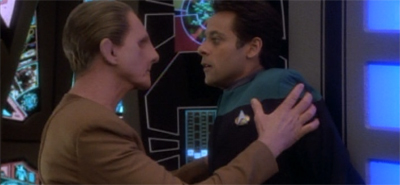
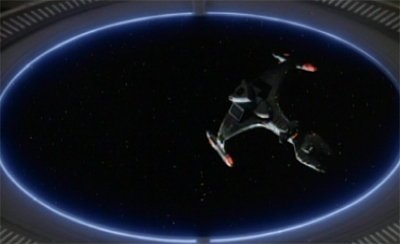
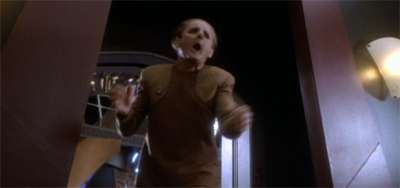

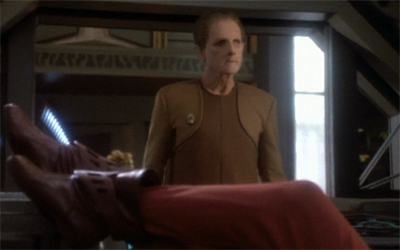
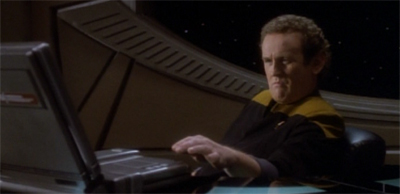

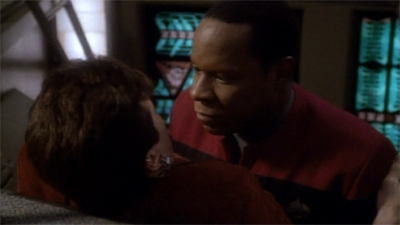
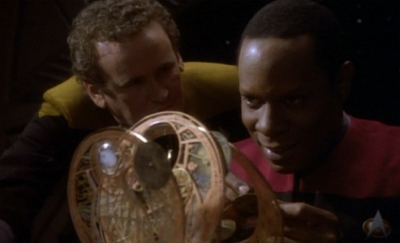
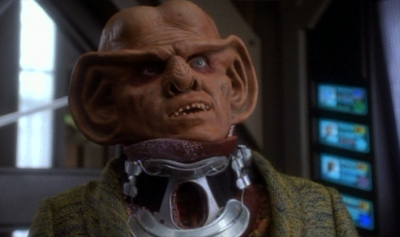

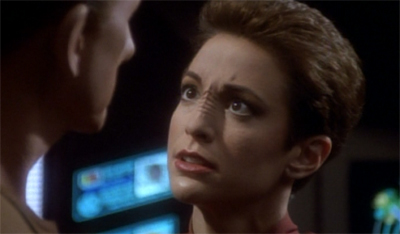




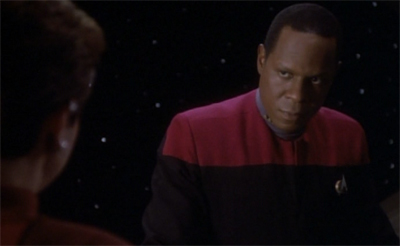





I thought the best take on Klingon culture came from that episode of Enterprise (one of the few I caught) where Archer meets a Klingon who tells him that not so long ago, the Klingon Empire wasn’t like it is now, and being a lawyer or [insert other non-military profession] was considered a perfectly good job… but then the militaristic ideology took over and every profession other than warrior became frowned upon. It explains how the Klingons were able to advance all the way into space despite the way their culture works. Presumably they used to be a modern society like the Romulans or the Federation, and while society’s regressed since then, they’re still living off of what their ancestors left them.
I think the episode you’re talking about is “Judgment.” If I recall, it’s one of a handful of good episodes in the otherwise dire second season of Enterprise. Fun fact: after two years of Voyager (without DS9 in the background), it was the second season of Enterprise that made me give up on the franchise. I didn’t catch the (surprisingly good) third and fourth seasons until after it was cancelled.
But Judgment is a good little episode, like Cogenitor or Dead Stop or even Minefield. It’s certainly the best use of the Klingons since Ronald D. Moore left the franchise, which is a pretty damning indictment given how frequently they appeared in the first season of Enterprise.
Although Klingon history in the franchise is a bit of a mess. I believe The Sword of Kahless suggests that the Klingons were a slave race who revolted against their masters and took over the Empire. (“the Hurq” or something.) The inference was that Klingons got a hold of various advanced technologies that it’s hard to imagine their society developing by itself. (Warp drive and stuff, according to various spin-off material.) It was a pretty big idea, and I was a bit surprised that it was just casually thrown in and never mentioned again.
Thanks for this great review! I apprecitated the episode a lot more after this. What I found great from the start was that it managed to show us the characters’ deep-layered flaws/tendencies and the tension between them in a mind-control setting but without the mistakes of other early-series stories like “The Naked Now” or “Babel” where we got somewhat completely altered characters. That alone I would deem a great accomplishment – and its is a suspenseful and fun show at the same time (stiff neck Quark, Dax straining everyone’s nerves, etc.).
Glad you enjoyed. Always really loved this episode. Like The Nagus, I think it’s massively underrated by DS9 fans.